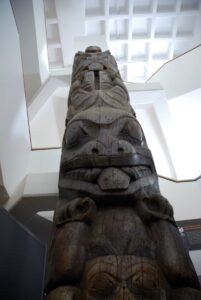Now in the Hudson Museum
Now In The Merritt Gallery
Body Adornment: Ethnographic Jewelry from Around the World
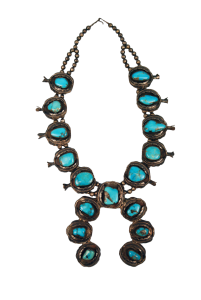
Precious metals, gems, stones, feathers, shells, glass, and even insects were used by cultures from around the world to adorn the body, serve as manifestations of wealth and mediums of economic exchange, acknowledge an individual’s cultural and social identity, and enhance one’s physical appearance. This exhibit provides a glimpse into what constitutes beauty from North America, Oceania, Mesoamerica, Africa, and South America?
Visit the Merritt Gallery in the Hudson Museum to explore a wide array of body adornments from around the world.
Now in the Minsky Culture Lab
Land of Fire and Ice: Investigating the End of the Last Ice Age in Tierra del Fuego, Chile
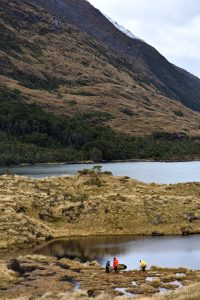 In March of 2023, a team from the University of Maine, the University of Cincinnati, the Universidad de Chile, and the Universidad de Magallanes went to Tierra del Fuego, Chile, to research the end of the last ice age. This exhibit showcases that research, along with the breathtaking beauty of the landscape in which they worked and lived during their time moving between remote locations along the Beagle Channel on a 66′ sailboat.
In March of 2023, a team from the University of Maine, the University of Cincinnati, the Universidad de Chile, and the Universidad de Magallanes went to Tierra del Fuego, Chile, to research the end of the last ice age. This exhibit showcases that research, along with the breathtaking beauty of the landscape in which they worked and lived during their time moving between remote locations along the Beagle Channel on a 66′ sailboat.
Visit the Minsky Culture Lab in the Hudson Museum to explore their research and enjoy the beauty of the landscape and wildlife they encountered.
Permanent Hudson Museum Exhibits
The Wabanaki Gallery
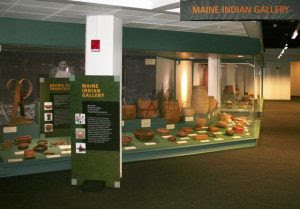 The Native people of Maine have legends that tell of how the Creator made a being: Gluskabe. Gluskabe made the people and taught them how to respect and use the natural resources of their world, especially the trees and plants. He showed them how to make baskets, birchbark containers and canoes, and how to carve. Among the Hudson Museum’s holdings are over 500 examples of the material culture of Maine’s Maliseet, Mi’kmaq, Passamaquoddy, and Penobscot peoples and hundreds of historic images. This assemblage includes brown ash splint and sweet grass basketry dating from 1850 to the present along with an important collection of basketmaking tools and molds, birchbark containers and implements, rootclubs, crooked knives, snowshoes, beadwork, and three full-size canoes.
The Native people of Maine have legends that tell of how the Creator made a being: Gluskabe. Gluskabe made the people and taught them how to respect and use the natural resources of their world, especially the trees and plants. He showed them how to make baskets, birchbark containers and canoes, and how to carve. Among the Hudson Museum’s holdings are over 500 examples of the material culture of Maine’s Maliseet, Mi’kmaq, Passamaquoddy, and Penobscot peoples and hundreds of historic images. This assemblage includes brown ash splint and sweet grass basketry dating from 1850 to the present along with an important collection of basketmaking tools and molds, birchbark containers and implements, rootclubs, crooked knives, snowshoes, beadwork, and three full-size canoes.
These objects, and collections on loan from other Museums in New England, are presented in this exhibit, together with audio and video footage of fifteen Wabanaki artists. The film footage documents how raw materials are gathered, processed and prepared, and how each of the artforms is made. These film segments are available to explore in two Native Voices kiosks.
Across from the presentation of Wabanaki material culture, UMaine researchers present their research and collections. These collections have rarely been exhibited to the public and until now have been used almost exclusively for research. This portion of the exhibit includes artifacts gathered by UMaine archaeological projects and housed in the collections of the Anthropology Department. Points, scrapers, adzes, awls, and potsherds from a wide variety of archaeological sites may be found as well as evidence of the Ice Age in Maine. In addition to the archaeological collection, a time-lapse presentation shows the glaciation of Maine during the ice age, the receding of glaciers and the appearance of land, the types of vegetation and animal life that developed in the state, the changing of plant and animal species over time, and the peopling of Maine. This segment draws on research of the Climate Change Institute to assess the impact of these changes on our state.
World Cultures Gallery
Previous exhibitions of the Hudson Museum’s culturally diverse collections centered on presenting one culture area per exhibit. The Museum’s collections are extraordinarily rich, but are not comprehensive. To use our collections to their best advantage, the new World Cultures Gallery—the centerpiece of the Museum’s exhibitions—presents the richness and breadth of the Museum’s holdings. It features objects that have never been on public exhibition, and allows the Museum to exhibit a greater percentage of its holdings. 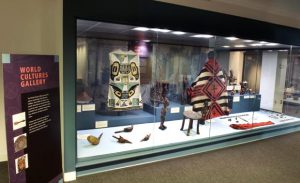
The gallery consists of eight large-scale display units, including one devoted exclusively to the William P. Palmer Collection III collection of Precolumbian artifacts. Each exhibit case focuses on a specific cultural theme universal to people around the world. Visitors will be able to compare and contrast how people from a variety of cultures are similar and how they are different; how they solve basic issues; and how their environment affects their solutions.
Themes featured in the gallery include ritual and belief, status and power, home and family, transportation, adornment, foodways, and objects made for others. For example, a case devoted to status and power displays Northwest Coast Chilkat robes and tunics; African stools, staffs, and ancestor figures; a Phase III Navajo Chief’s blanket and Southwestern jewelry; and Precolumbian pottery figurines of nobles, rulers and the elite.


